 It seems to me that today’s world has a desperate need for “change-makers,” the kind who have spiritual strength and focus. Can we see ourselves in that role? If so, we need to dedicate ourselves to a life-path filled with practices that build up, enhance and release our innate capacities for love and beauty, peace and harmony, justice and joy, awe and mystery. In this way we are connected to the great “sacred spirit” of the universes.
It seems to me that today’s world has a desperate need for “change-makers,” the kind who have spiritual strength and focus. Can we see ourselves in that role? If so, we need to dedicate ourselves to a life-path filled with practices that build up, enhance and release our innate capacities for love and beauty, peace and harmony, justice and joy, awe and mystery. In this way we are connected to the great “sacred spirit” of the universes.
 Even though there has been regression in our national leadership and recent policies, our lives can be filled with hope through spiritual experiences. We find this in the breath of the seasons of the earth. Locally we have gone far too long without the seasonal rains, yet the Goddess is still prodding nature to blossom, green and grow.
Even though there has been regression in our national leadership and recent policies, our lives can be filled with hope through spiritual experiences. We find this in the breath of the seasons of the earth. Locally we have gone far too long without the seasonal rains, yet the Goddess is still prodding nature to blossom, green and grow.
It is as if every page of Gaia’s coloring book is being filled in and coming alive. This is the greening power that Hildegard von Bingen often wrote and sang about. The “Goddess” isn’t creating and ruling the world, the universes — She is the world, the universes. We don’t believe in the Goddess so much as experience her in our lives.
The Soul is Breath
by Hildegard von Bingen
 The soul is the breath of the living spirit
The soul is the breath of the living spirit
that with excellent sensitivity,
permeates the entire body to give it life.
Just so,
the breath of air makes the earth fruitful,
Thus the air is the soul of the earth,
moistening it,
greening it.
Hildegard of Bingen (1098-1179) was a remarkable woman, a “first” in many fields. At a time when few women wrote, Hildegard, known as “Sybil of the Rhine”, produced major works of theology, visionary writings as well as medical and science texts. When few women were given respect, she was consulted by bishops, popes, and kings.
Hildegard used the curative powers of natural things for healing and wrote treatises about natural history and the medicinal uses of plants, animals, trees and stones. She is the first composer whose biography is known, and she founded a vibrant convent where her musical plays were performed.

Revival of interest in this extraordinary woman of the Middle Ages was initiated by musicologists and historians of science and religion. Hildegard’s visions and her music continue to be performed and reinterpreted in many new artistic venues. Her story is one of a resilient spirit and vivacious intellect overcoming social, cultural, and gender barriers to achieve timeless transcendence.
May these photographic images invite you to become a sister of Hildegard, further exploring the beauty of nature and the possibilities of the human spirit in ourselves and others. Together, may we be a force that will change the course of human history, helping the greening process of a world in need of new life and hope. Blessed She!

 Iris, Blooming
Iris, Blooming  that, opening to spring life,
that, opening to spring life, Plant us into the gardens
Plant us into the gardens
 For as long as I can remember, the cherry blossoms in Golden Gate Park come and go many weeks before the festival in Japantown. That will probably be the case again this year since the trees are right now swinging into full bloom. Perhaps the festival is primarily about Japanese culture rather than just this iconic tree.
For as long as I can remember, the cherry blossoms in Golden Gate Park come and go many weeks before the festival in Japantown. That will probably be the case again this year since the trees are right now swinging into full bloom. Perhaps the festival is primarily about Japanese culture rather than just this iconic tree. When I stand beneath the cherry tree’s umbrella branches laden with her delicate petals, I am grateful that the blossoms precede the festivities. According to the universal language of flowers the meaning of the cherry blossom is “spirituality and beauty.â€Â The ancients worshiped the Great Mother Asherah under every living tree, and certainly we can join them beneath the pink and white canopy of the cherry.
When I stand beneath the cherry tree’s umbrella branches laden with her delicate petals, I am grateful that the blossoms precede the festivities. According to the universal language of flowers the meaning of the cherry blossom is “spirituality and beauty.â€Â The ancients worshiped the Great Mother Asherah under every living tree, and certainly we can join them beneath the pink and white canopy of the cherry. In the Judeo-Christian tradition Asherah was also known as Mother Nature, and, gazing up from the trunk through these branches, I can see why. Unfortunately, the King James Version of the Bible replaced the name Asherah with “tree†or “grove of trees†and her place of honor was deliberately deported to the recesses of failing memory. But separated from the tree of life, our Mother Goddess, we truly flounder. So even a solitary walk among the cherry trees can help her seep back into our consciousness. A bumper sticker implores us to “honor thy mother†and shows us a picture of the earth. So, to honor our mother, I chose this week to focus closely on individual and groupings of cherry blossoms.
In the Judeo-Christian tradition Asherah was also known as Mother Nature, and, gazing up from the trunk through these branches, I can see why. Unfortunately, the King James Version of the Bible replaced the name Asherah with “tree†or “grove of trees†and her place of honor was deliberately deported to the recesses of failing memory. But separated from the tree of life, our Mother Goddess, we truly flounder. So even a solitary walk among the cherry trees can help her seep back into our consciousness. A bumper sticker implores us to “honor thy mother†and shows us a picture of the earth. So, to honor our mother, I chose this week to focus closely on individual and groupings of cherry blossoms. You can also use the flash to counterbalance strong natural light that may be too overpowering for your floral subject. For example, if you find very strong light in the background, your flower may look like a silhouette. Add some fill-flash and you’ve corrected that imbalance quickly and simply. This way you can have a well-lit cherry blossom and a beautiful blue sky — provided of course that it is not a foggy day.
You can also use the flash to counterbalance strong natural light that may be too overpowering for your floral subject. For example, if you find very strong light in the background, your flower may look like a silhouette. Add some fill-flash and you’ve corrected that imbalance quickly and simply. This way you can have a well-lit cherry blossom and a beautiful blue sky — provided of course that it is not a foggy day.
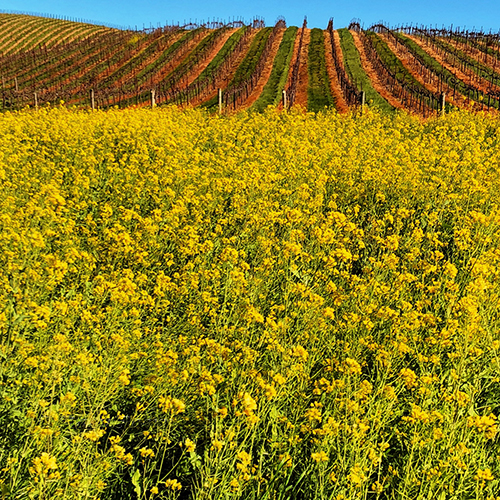 Myth says the mustard was planted by California missionaries as they walked from mission to mission dropping mustard seeds. They knew that, on the next years’ journey when the path was overgrown with grass and vegetation, the yellow of the mustard would mark the way. Each mission is planted about one day’s walk from the other.
Myth says the mustard was planted by California missionaries as they walked from mission to mission dropping mustard seeds. They knew that, on the next years’ journey when the path was overgrown with grass and vegetation, the yellow of the mustard would mark the way. Each mission is planted about one day’s walk from the other.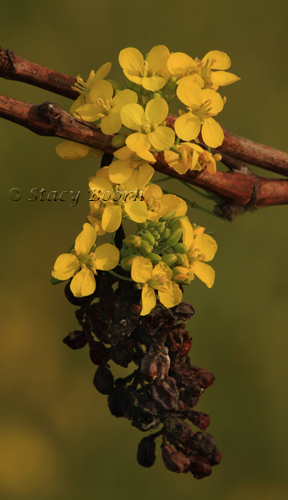 For me, the mustard supplies oceans of yellow as subject or background color. The naked grape vines seem to emerge from the flowing yellow much like palm kelp at low tide. Lots of depth-of-field captures the merging lines of the rows of vines and the yellow pathways between them.
For me, the mustard supplies oceans of yellow as subject or background color. The naked grape vines seem to emerge from the flowing yellow much like palm kelp at low tide. Lots of depth-of-field captures the merging lines of the rows of vines and the yellow pathways between them.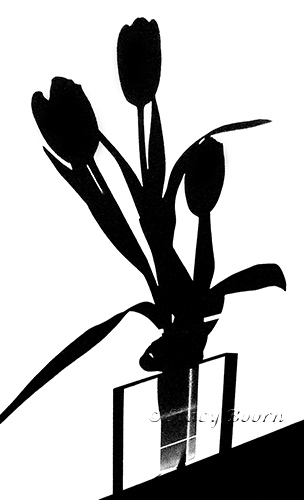 Today is the 50th anniversary of Dr. Martin Luther King, Jr’s assassination. Along the path of racial equality in the past 50 years there have been some beautiful blooming stalks of justice. But as of late it seems entrenched white supremacy and systemic racism have started to take greater hold in our fields of dreams. I hope one or two stalks of mustard are still blooming on May 8, Julian’s feast day so that we hear the yellow flowers sing out: “All shall be well, and all shall be well, and all manner of things shall be well.â€Â May we rise up to make it so!
Today is the 50th anniversary of Dr. Martin Luther King, Jr’s assassination. Along the path of racial equality in the past 50 years there have been some beautiful blooming stalks of justice. But as of late it seems entrenched white supremacy and systemic racism have started to take greater hold in our fields of dreams. I hope one or two stalks of mustard are still blooming on May 8, Julian’s feast day so that we hear the yellow flowers sing out: “All shall be well, and all shall be well, and all manner of things shall be well.â€Â May we rise up to make it so!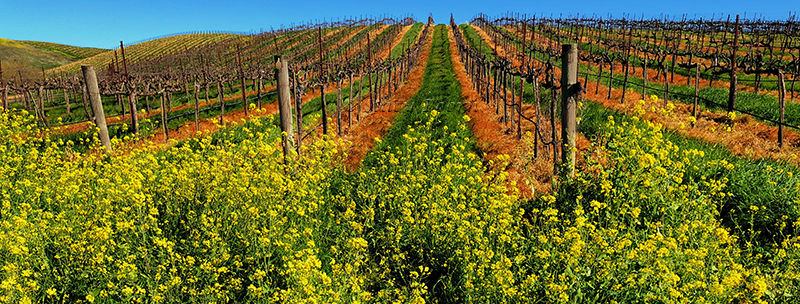
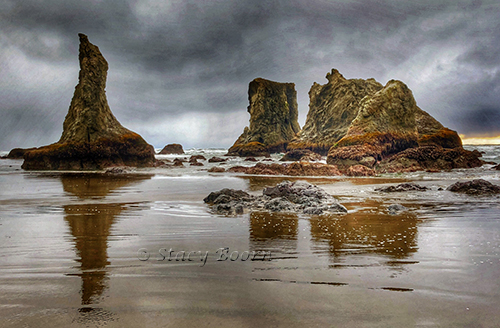 At the beginning of this month I spent a few days along the southwestern coast of Oregon. I had anticipated beach walks at low tide to scour the base of seastacks for anemones and sea stars. As well, I had hoped for beautiful sunsets and sunrises over the waves and winged ones taking flight. But instead I encountered cold, rainy, windy and even snowy days and nights.
At the beginning of this month I spent a few days along the southwestern coast of Oregon. I had anticipated beach walks at low tide to scour the base of seastacks for anemones and sea stars. As well, I had hoped for beautiful sunsets and sunrises over the waves and winged ones taking flight. But instead I encountered cold, rainy, windy and even snowy days and nights. Fortunately I had a beautiful room in the Bandon Beach Motel right on the cliff edge. I could look west and south over a most beautiful stretch of scenic jagged coastline. Several times I donned waterproof clothes to walk in the pelting rain to take a few photos. Those few days were all about water from the sky, the ebb and flow of the ocean, and the snow blanketing the coastal hills.
Fortunately I had a beautiful room in the Bandon Beach Motel right on the cliff edge. I could look west and south over a most beautiful stretch of scenic jagged coastline. Several times I donned waterproof clothes to walk in the pelting rain to take a few photos. Those few days were all about water from the sky, the ebb and flow of the ocean, and the snow blanketing the coastal hills. Streams and wetlands are threatened by efforts to roll back the Clean Water Plan.
Streams and wetlands are threatened by efforts to roll back the Clean Water Plan. Let there be water, water, everywhere – clean water accessible to all peoples! Like Rwanda we can do this. May the ocean, even on cold and foreboding days, inspire us with her beauty.
Let there be water, water, everywhere – clean water accessible to all peoples! Like Rwanda we can do this. May the ocean, even on cold and foreboding days, inspire us with her beauty. It seems to me that today’s world has a desperate need for “change-makers,” the kind who have spiritual strength and focus. Can we see ourselves in that role? If so, we need to dedicate ourselves to a life-path filled with practices that build up, enhance and release our innate capacities for love and beauty, peace and harmony, justice and joy, awe and mystery. In this way we are connected to the great “sacred spirit” of the universes.
It seems to me that today’s world has a desperate need for “change-makers,” the kind who have spiritual strength and focus. Can we see ourselves in that role? If so, we need to dedicate ourselves to a life-path filled with practices that build up, enhance and release our innate capacities for love and beauty, peace and harmony, justice and joy, awe and mystery. In this way we are connected to the great “sacred spirit” of the universes. Even though there has been regression in our national leadership and recent policies, our lives can be filled with hope through spiritual experiences. We find this in the breath of the seasons of the earth. Locally we have gone far too long without the seasonal rains, yet the Goddess is still prodding nature to blossom, green and grow.
Even though there has been regression in our national leadership and recent policies, our lives can be filled with hope through spiritual experiences. We find this in the breath of the seasons of the earth. Locally we have gone far too long without the seasonal rains, yet the Goddess is still prodding nature to blossom, green and grow. The soul is the breath of the living spirit
The soul is the breath of the living spirit
 Walking a bridge can be a spiritual experience. It enables a person to notice things from various vantage points not possible without it. Many bridges span vast bodies of water or deep dark gorges, places ineffably beautiful but otherwise treacherous to cross.
Walking a bridge can be a spiritual experience. It enables a person to notice things from various vantage points not possible without it. Many bridges span vast bodies of water or deep dark gorges, places ineffably beautiful but otherwise treacherous to cross. Sometimes the bridge is so lost in fog that I begin to meld with the liquid gray, causing the emotional noise in my life to fade into the background of that day’s journey. At other times, when puffy clouds are serenely dancing around the towers, a great sense of playfulness enters my veins and refuses to leave. Try to get back to the reality of a workday after that! Recently fog and puffy clouds, blue sky and sunrays merged around the south tower presenting what seemed a bridge to nirvana. Boats sailed below. That beautiful orange icon did it again, taking me to places of peace, joy, challenge and adventure.
Sometimes the bridge is so lost in fog that I begin to meld with the liquid gray, causing the emotional noise in my life to fade into the background of that day’s journey. At other times, when puffy clouds are serenely dancing around the towers, a great sense of playfulness enters my veins and refuses to leave. Try to get back to the reality of a workday after that! Recently fog and puffy clouds, blue sky and sunrays merged around the south tower presenting what seemed a bridge to nirvana. Boats sailed below. That beautiful orange icon did it again, taking me to places of peace, joy, challenge and adventure. The steel and concrete bridges around us can remind us of that, as can other types of bridges. The internet, for example, is a kind of “cyber-bridge” which connects “real to virtual.”
The steel and concrete bridges around us can remind us of that, as can other types of bridges. The internet, for example, is a kind of “cyber-bridge” which connects “real to virtual.”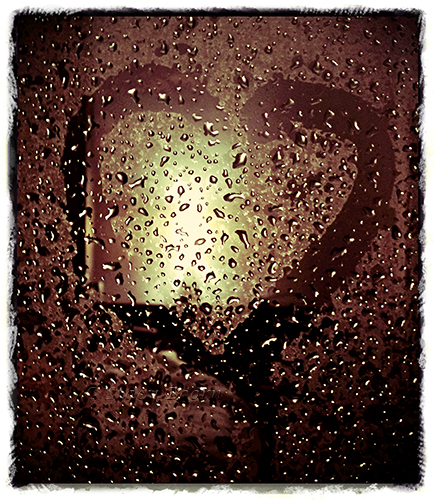 In the early winter months I enjoy photographing migratory birds, mushrooms and rain. Until a few days ago the mushrooms and rain were very scarce. But today I am able to sing a favorite song from my childhood: “I saw raindrops on my window, joy is like the rain. Laughter runs across my pane, slips away and comes again, joy is like the rain.â€Â These words were penned and put to music by Miriam Teresa Winters, the Roman Catholic feminist who has called herself a “dissident in place.”
In the early winter months I enjoy photographing migratory birds, mushrooms and rain. Until a few days ago the mushrooms and rain were very scarce. But today I am able to sing a favorite song from my childhood: “I saw raindrops on my window, joy is like the rain. Laughter runs across my pane, slips away and comes again, joy is like the rain.â€Â These words were penned and put to music by Miriam Teresa Winters, the Roman Catholic feminist who has called herself a “dissident in place.” The Trump administration and Trump’s Environmental Protection Agency administrator Scott Pruitt are championing 30 percent cuts to the EPA’s budget. That would take its funding to its lowest level since the 1970s. At the same time, industry insiders and lobbyists are being appointed to EPA leadership positions to oversee the polluting industries they come from.
The Trump administration and Trump’s Environmental Protection Agency administrator Scott Pruitt are championing 30 percent cuts to the EPA’s budget. That would take its funding to its lowest level since the 1970s. At the same time, industry insiders and lobbyists are being appointed to EPA leadership positions to oversee the polluting industries they come from.
 We are in the Season of Darkness, the time of “Advent,†which signals waiting, watching and anticipating with hope that something to come will change our lives and regenerate our world. Much of our northern hemisphere is guided by the natural seasonal switch to a grayer and colder time. It is the onset of winter, but here in central California the otherwise wet season continues to be dry and sunny with mildly warm temperatures. Our skies are glowing orange because smoke particles from the wildfires of southern California are reflecting the setting sun. The intensity of the wildfires is exacerbated by the warming climate, and, in turn, the smoke and heat that is produced accelerates climate change. We need a societal change of heart and the hope that would bring.
We are in the Season of Darkness, the time of “Advent,†which signals waiting, watching and anticipating with hope that something to come will change our lives and regenerate our world. Much of our northern hemisphere is guided by the natural seasonal switch to a grayer and colder time. It is the onset of winter, but here in central California the otherwise wet season continues to be dry and sunny with mildly warm temperatures. Our skies are glowing orange because smoke particles from the wildfires of southern California are reflecting the setting sun. The intensity of the wildfires is exacerbated by the warming climate, and, in turn, the smoke and heat that is produced accelerates climate change. We need a societal change of heart and the hope that would bring. Perhaps the most boisterous are the California Sea Lions which are known for their intelligence, playfulness, and noisy barking. They are very social animals, and groups often rest closely packed together at favored haul-out sites on land or float together on the ocean’s surface in living “rafts.” Sometimes they can be seen “porpoising,” or jumping out of the water, presumably to add speed to their swimming.
Perhaps the most boisterous are the California Sea Lions which are known for their intelligence, playfulness, and noisy barking. They are very social animals, and groups often rest closely packed together at favored haul-out sites on land or float together on the ocean’s surface in living “rafts.” Sometimes they can be seen “porpoising,” or jumping out of the water, presumably to add speed to their swimming.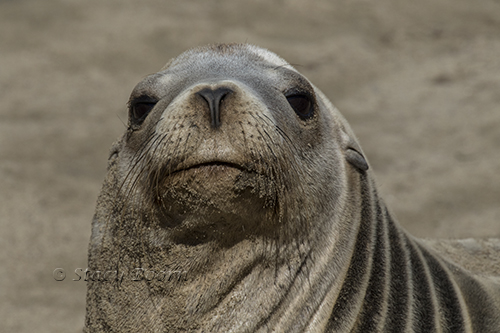 At a recent encounter with hundreds of sea lions hauled out on a beach near Elk Horn Slough, I was convinced they were barking out the tune to “O Little Town of Bethlehem.â€Â So I joined in with the beautiful lyrics that Jann Aldredge-Clanton has married with that traditional tune:
At a recent encounter with hundreds of sea lions hauled out on a beach near Elk Horn Slough, I was convinced they were barking out the tune to “O Little Town of Bethlehem.â€Â So I joined in with the beautiful lyrics that Jann Aldredge-Clanton has married with that traditional tune: O Holy Christ-Sophia, your image black and fair,
O Holy Christ-Sophia, your image black and fair,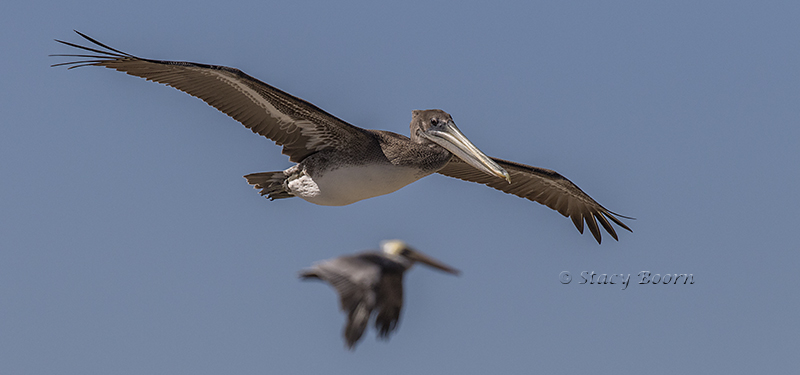 In the 1960s and ’70s, the Brown Pelican became a rare sight along the U.S. coastlines. The pelican decline was the result of the use of pesticides such as DDT which caused pelican eggshells to thin beyond the shells’ ability to hold and incubate their offspring. With the banning of DDT, the Brown Pelican populations have recovered.
In the 1960s and ’70s, the Brown Pelican became a rare sight along the U.S. coastlines. The pelican decline was the result of the use of pesticides such as DDT which caused pelican eggshells to thin beyond the shells’ ability to hold and incubate their offspring. With the banning of DDT, the Brown Pelican populations have recovered.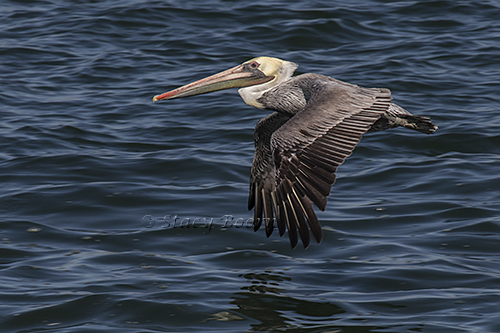 In the Middle Ages, Saint Gertrude of Helfta had a vision of Christ as a pelican. Inspired by Psalm 102, the church interpreted the female pelican as a symbol of Christ, believing this magnificent bird was able to give her life-restoring blood to her dead offspring. This metaphor was based on a popular fallacy, yet the imagery of the mother pelican returning to her brood to restore them to life continues to spark my spiritual imagination.
In the Middle Ages, Saint Gertrude of Helfta had a vision of Christ as a pelican. Inspired by Psalm 102, the church interpreted the female pelican as a symbol of Christ, believing this magnificent bird was able to give her life-restoring blood to her dead offspring. This metaphor was based on a popular fallacy, yet the imagery of the mother pelican returning to her brood to restore them to life continues to spark my spiritual imagination. She continues: “Exclusively male images of God are killing our spirit by distorting our understanding of masculinity, femininity, and mutuality. The recognition of biblical images of God as female, the infusion of positive female images into the language of faith, the achievement of balance between male and female references, will do a lot to bring us renewed health.†The Divine Feminine, page 47.
She continues: “Exclusively male images of God are killing our spirit by distorting our understanding of masculinity, femininity, and mutuality. The recognition of biblical images of God as female, the infusion of positive female images into the language of faith, the achievement of balance between male and female references, will do a lot to bring us renewed health.†The Divine Feminine, page 47.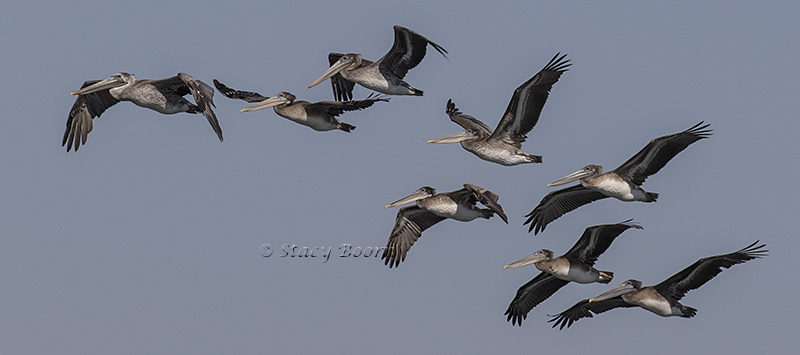 I love the Brown Pelican’s feathers! Like all other birds, their feathers define them and are unique to each. As the Brown Pelican matures its plumage will change. In addition, its plumage changes from season to season. No other animal has feathers. The feather itself is a complex product of the bird’s skin, and its structure is one of nature’s greatest wonders. “My heart in hiding stirred for a bird, — the achieve of, the mastery of the thing!†– Gerard Manley Hopkins (1844-1889), English poet.
I love the Brown Pelican’s feathers! Like all other birds, their feathers define them and are unique to each. As the Brown Pelican matures its plumage will change. In addition, its plumage changes from season to season. No other animal has feathers. The feather itself is a complex product of the bird’s skin, and its structure is one of nature’s greatest wonders. “My heart in hiding stirred for a bird, — the achieve of, the mastery of the thing!†– Gerard Manley Hopkins (1844-1889), English poet.